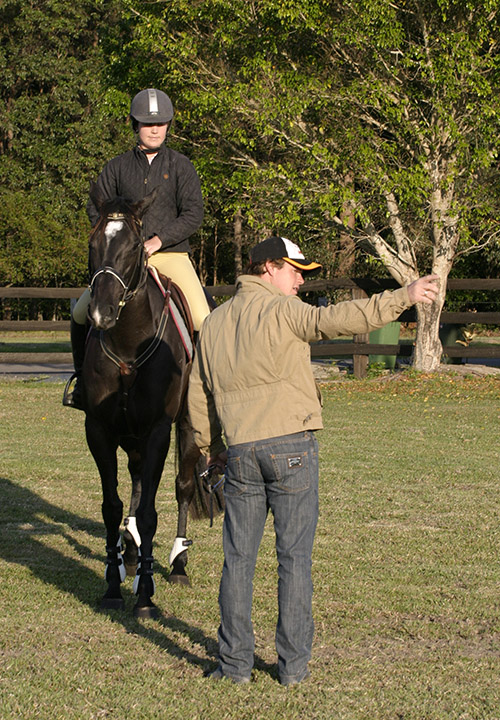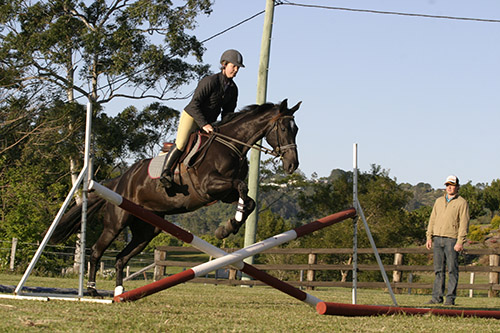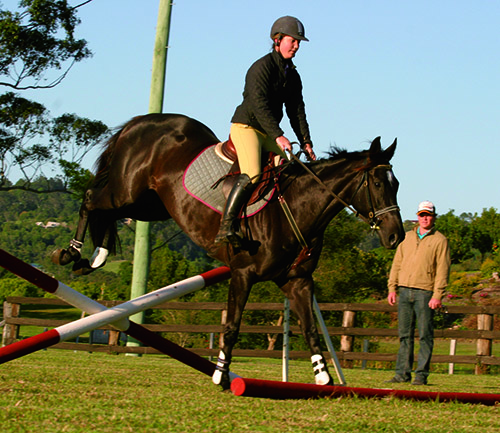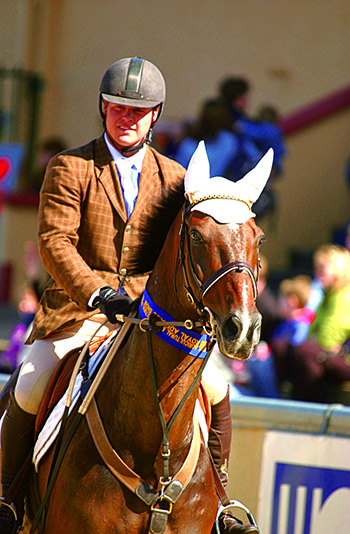Alexandra Bruggisser continues her training series with one of the up-and-coming stars of the showjumping scene.
Rod Scott took the photos…
Last month, we left Sunshine Coast local and World Cup show jumper, Billy Raymont, having looked at the initial stages of training a young show jumper. We actually fibbed a little. Our model horse, Betty, is a green Thoroughbred mare taken off-the-track by Billy but she has actually been lightly campaigned with her new owner, promising junior, Kym Hilly. This month we focus on Billy’s development of his training scale to prepare youngsters for their first competition… Or in this case to continue developing their skills and confidence.
“Ok, we are now going to move on a little with this one and try to get her ready to go to the show. So we need to just train the lines, make sure she is jumping through a double and get her jumping around a little bit of a course. Making sure that she’s happy enough seeing a few spooky things that she might not have seen too much of, but basically making sure that she’s rideable enough, that you can get her down the lines. We want her so she’s ready to go to the show and cope with all of that.”
As he explained last month, time spent riding in Europe has helped Billy form a structured approach to how he trains his horses: Always work for number 1 – to get the horse relaxed. In time, this allows for number 2 – encourage the horse to use its neck and shoulders and number 3 will follow – let the jump come.
What happens today is no different, the training is always progressive… “So, let’s just start off catching one or two on their own and then we’ll jump down this line a couple of times. We might even change the distance we go down there, ok?”
As Kym continues to pop over the 60-70 cm jumps set up around the arena, I am reminded that Billy is a stickler for position – a result of him studying other riders and having an understanding of the importance of leaving it to the horse to do the jumping. It is obvious from Kym’s position that it is something Billy also emphasises in his teaching. While it may sound like Billy is a strict coach, he is a great communicator and the atmosphere in the lessons is very conducive to learning. Betty is Kym’s first youngster and it is a pleasure to watch Billy help her understand the importance of progressing in accordance with the horse accepting and relaxing in each exercise.
For the moment though, Billy keeps it simple and understandable, right back to the basics, as Betty has “picked something out she doesn’t like.”
Time to work on the little spook…
“Just jump the oxer again. Make sure you start to close your leg on her NOW before she starts looking… That’s ok that’s pretty typical of what a youngster would do at that point. So it’s important again that you give her all the support that you can. She needs you to get your leg on her a little bit when she’s coming off the turn, just so that she knows you’re going somewhere and that you’re supporting the idea of going there.”
“Ok? You’ve kind of got to ask her and then say yup that’s what I want, that’s what I want. I want you to go to that. At the same time trying to keep her straight, not offend her if she over jumps by falling back on her mouth or getting loose and falling all over her. It’s still important to be really still. When they’re at this point you’ve got to give them all the confidence you can.”
It’s not just the horse’s confidence I can see benefiting from Billy’s easy-going and systematic approach. Everything he says makes sense and Kym continues to take everything in her stride, totally absorbed in the progress of her young mare.
“When you’re in the ring jumping a round you want to know you can take your time, use all of your arena and make sure you’re organised before tackling another jump or a line. Again just trying to support her and keep her confident. It’s so important to keep them confident all the way through.”
I think ‘support’ is a great way of describing how to keep them forward and motivated. Not hunting them and creating more tension but just being there, always encouraging and always reassuring.
… And it works! Betty is working sweetly forward now and it is time to move on to practising some lines. Billy emphasises that before a competition you should “practise as many lines as you can think of… We’ve already done the basic stuff (as in the first part of the series) and you’ve got them jumping around, jumping single fences. Some gridwork to actually help train their jump a little bit. So they’re ready to jump some metre/metre ten tracks and go to the show.”
The exercise is a double of verticals and on approach Kym is already under scrutiny…
“Now get your leg on her off the turn and support the idea a little bit. Good, two, three, four, five, six. Ok, so the same line which walks five strides we can play around with, if it’s small enough, adding a stride and things like that. Again just working on the rideability and the organization and just helping to prepare them for maybe some odd and uneven distances we might get at the show, which we might not like. Again, make sure you get a good true distance to the first so you can come down in a nice, soft, even five. Great, good.”
“With the youngsters like this, and any horse for that matter, it’s important to have walked your course, know what a line is. Even in training, know what the line is so that you can set her up in the best way you can to jump that line. Before you get to the line, you need to create the canter that you need to get down that line. So if it’s a bit of an open line you need to get your canter more opened up and try to catch the first pretty solid so you can just keep going. If it’s a slightly shorter line you’ve still got to jump the first fence but in the turn you want to get your canter more connected, more closed up. Just so that when you do land after that first jump she’ll be more responsive on landing so you can get her back.” “We’ve done that line now in five, let’s try it in six a few times. Make sure that we have her rideable enough, so that you can still add a stride down a line like that, but she can still have a good enough canter and jump it well when she gets there. So constantly between the fences, no matter what level they’re at, we have to keep making the canter, working on that connectivity.”
But Billy isn’t happy with the quality of the canter…
“Stay on the circle for a second, Kym. We’ll try to get her canter more prepared for doing the six strides down that line. So you want to close it up. Basically what we’re doing now is a shorter distance line. We want to close the canter up, get your leg on, make sure that it’s still active, because we don’t want to wait and shut her down and not have her active enough to still give a good jump. So even though we want to wait a little to the first fence to make it easier to get that extra stride, she still has to be active.”
Throughout the lessons I watched, Billy never seemed fazed by the horse’s reactions. Now I find that the reason is that he’s always thinking about what might happen…
“So if the first time’s not so good, it’s just a matter of practising it and getting that canter more prepared. You’ve got to close it up even more. Make sure it stays active. You can keep a little contact over the first fence if you like.”
Betty is finding it difficult to shorten her stride so much and stay balanced for the second fence, so Billy tries to find a middle ground…
“Ok let’s go back to doing five strides but making sure she’s not opened up and flat, it still has to be connected and active.”
Having gone through some straight lines in both a bigger and a shorter canter, it’s time to try some curving lines.
“I want you to sure that she’s nice and straight when we get there, jumping each fence individually but still they are jumped as a line. Making sure that you’re not still turning when you get there. You have to break the line into two and make your turn in the middle.”
“It’s generally not a curve all the way from one to the other because we still want to be able to jump each jump very, very straight. So with a young one, this can take a little while because they can be slow through the turns. Curving lines in tracks for younger horses can be difficult. But you’ll meet them often and we definitely have to train it. So we practise that, both curves, left and right, making sure we can manage a line like that.”
From the start there’s a problem – Billy is quick and constructive in fixing it with more easy to follow logistics:
“Ok, we can’t really do it if she’s not on the right lead. She needs to know what direction she’s going so that she’s on the right lead to start with. I think you need to get her to land on the left lead first so that you can do that a bit sweeter. Do more at that first fence to make sure she’s on that left lead. You want them to learn to get their leads just by looking in the direction they’re heading. Generally by looking, it makes us do enough with our body to send them a message anyway as to what direction we want to go.”
Now I’m the one that’s a little confused – I thought the essence of jumping was a super still position??
“But if they don’t, then we’ve got to practise it because we need them to be able to find their leads by such a subtle thing because we don’t want to be moving around too much and getting all over the place. The idea is to have it look as simple as possible.”
Right, so as I understand it then, it is essential to remain still but no matter how hard we try to refrain from interfering, we do and horses, the sensitive creatures they are, pick up on our ever so minor cues.
Running through Billy’s mental checklist of things to do before going to a show, it seems that Kym and Betty are getting close! “We’ve done some lines and they all seem to be working quite well now. We’ve done some more forward lines and then adding a stride down the same line so you know we’ve got her working so she’s moving forward and coming back. We tried the curving lines so that we can ride her through a bend or a dog leg line and be able to cope with that.”
But, there’s always “something else we probably need to do before we go to the show, like jumping some doubles, just to make sure that she isn’t spun out by jumping a couple in a row so closely. I think at home, especially with the young ones, two-stride doubles are really enough, I don’t jump too many one-stride doubles. Again it’s just about confidence, keeping them happy and making it all seem like it’s easy. We want them to think it’s easy.”
“We want them to stay relaxed about it, especially at this point. We don’t want them stressing about having to be careful or having to do anything too quickly. So two-stride doubles are good. You can start with them at three or four strides and close them up a stride at a time back to two strides. Generally you find then when you go to the show that you get a one-stride double and they sort of don’t worry about it, they just cope with it. Ok, we’ll do a bit of work through the double. Just catch that a few times on its own.”
Betty and Kym are now working in unison and there are no issues. The approach is calm, unhurried and the jump itself can develop power. As Billy predicted, Betty pops through unfazed by the duo of jumps, and canters on relaxed and listening after landing from the second jump.
“Now that we’ve played with a few different lines and we’ve jumped a couple of doubles, we really just want for a bit of practise, to jump a course or two. Just to make sure we can jump a line and then a different line and maybe open the canter up and bring it back for different lines, jump a double and then she’s pretty much ready for the show. Let’s just jump a course. So by jumping a course with the few lines that we’ve put together and the doubles and things like that, we’re just making sure that the horse is nice and rideable, happy enough to jump some lines, keep a relaxed mind, be able to find the right leads or make changes if they need to and basically just jump a nice relaxed, balanced round so that when we get to the show they just think that they’re doing the same as at home.”
“We’ve done the basics now. We’ve taught them about the poles, we’ve given them the little exercises, the really basic stuff, jumping around some simple little courses, keeping them relaxed. All we’re doing now by jumping some slightly bigger tracks, is getting them more ready for the show. Now this horse is ready to go to the show or a competition, preferably jump club or something like that.”
Billy Raymont – Riding to the Top
If Billy knew what he knows now when he first started out, he reckons he could’ve been where he is, a lot sooner. Well that’s no surprise right?! He says “anyone who wants to make a career out of horses should base themselves with a professional trainer for twelve months.”
Who knows what might have happened had someone older and wiser given Billy this advice, and he had taken it before he started his own operation. I know I’ve said it before, but how do you know what you need to know, when you don’t know what you don’t know?!! It’s an exasperating question!
In early October 1999, Billy took matters into his own hands and set off on his first real solo trip away from the Sunshine Coast, direction Werribee, Victoria. The plan was to do as much of the Southern show jumping circuit as possible as well as train along the way.
If you cast your mind back to what was happening in the world at that time you may remember that… Australia had just beaten France 35-12 in the Rugby Word Cup held in Wales (George Gregan was a new face in the Wallabies back line), Australian troops were carrying out peace-keeping duties in East Timor, Rogan Josh was soon to win the Melbourne Cup and according to the UN, the 6 billionth person in the world was born. Australia was also in full swing, preparing for the 2000 Olympics.
With all the hype there were plenty of World Cup shows, many acting as qualifiers for the Olympics, although as Billy states, he “wasn’t even dreaming of the Games at that point”.
With five horses on the truck, Billy stopped in at Murwullimbah and then Lismore competing at some of the bigger shows on his way South. His team consisted of: Martian Star, a Thoroughbred gelding he had bought unbroken and brought on himself to World Cups, Starmaker, a Thoroughbred gelding, off-the-track competing in Mini Prix (“he was very similar to Royal Selections so he was good preparation, Royal just had more scope”), Royal Selections himself, a six year old Thoroughbred gelding also brought along for the ride in the Mini Prix classes, a Thoroughbred mare, Midnight Special and a Thoroughbred stallion, Martian Star (by Silky Baby).
Continuing on his journey, Billy stopped to base himself in Western Sydney with George Sanna. While training with George at Chatham Park, he campaigned his horses at the Australian Championships – one of, if not the first event ever held at SIEC. George was influential in helping Billy to decide to stay on and he prolonged his trip, heading on to Victoria for more World Cup shows.
Staying in Victoria after Christmas, now stationed with Gavin Chester, Billy ricocheted up and down the countryside competing at show after show. With a general adjustment to the direction of movement, Billy began to progress North again, stopping at Castle Hill for the Australian Speed Championships. This proved to be a worthy stopping point as Starmaker won the coveted title.
After more than three months away, living in the truck, with five horses on the go, Billy returned home to find the Queensland show season up and running… While most people would be exhausted and ready to rip the horses shoes off and chuck them out into the back paddock for a month or two, Billy just kept on going! When I remark that horse people never seem to have a holiday he agrees but notes that before this life changing trip South he used to give his horses three months off over Summer and do something completely different like a bit of woodwork, a hobby he picked up after finishing school while doing some carpentry work with his Uncle.
Even though Billy was only away for a bit over three months, he claims the “whole trip was great! Training with George and travelling with teams that have done it before was fantastic!!”






